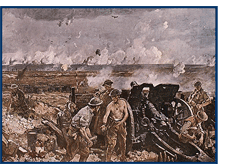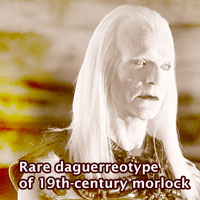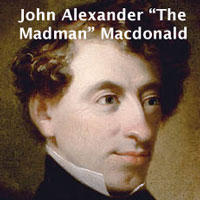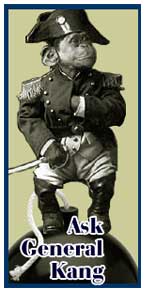
“Like most of you I was inclined to say the war was caused by fish.”
However, after a close examination of the evidence, Cadman Michaels — who held doctorates in theoretical physics and history, but who called himself an Alternate Historian — could say now with some confidence that the roots of World War III could be found in three things: beer, ice hockey and something called Tim Horton’s coffee.
He could say this with some confidence. And he did.
“My extensive work in multi-universal alternate histories, made possible by my invention, the Moorcock Inter-Dimensional Time Inversion Tunneller (patent pending), shows the cause of the war was actually much earlier in history, well before the breakup of Canada. I intend to outline this series of events in this presentation.”
There were grumbles from the learned audience at the annual History of WWIII Conference, held in sunny and (relatively) radiation-free Blenheim, NZ. The MIDTIT was controversial technology, but several papers had proved its efficacy at determining historical turning points.
“I’d have to say it stems from an incident in 1972, during the so-called Summit Series, an ice hockey match played between Canadian NHL players and the Russian Red Army team. Prior to the sixth game, played at the Luzhniki Palace of Sports in Moscow, Russian officials “lost” a shipment of beer the Canadian team had been expecting. Few other historians have noted how grumpy this made the Canadian players, and in particular, Bobby Clarke. ”
The audience stared at Michaels blankly.
“Clarke was the player who slashed Valeri Kharlamov’s ankle, fracturing it; this took him out of the next game, and made him ineffective for the final game.”
“Wait, that’s not true!” someone from the audience shouted.
“Exactly,” someone else said, Michaels thought it was Hans Gruber, Professor of Pre-Radiation Sports at the University of New Heidelberg, in Perth Australia. “Kharmalov played brilliantly in the remaining games, which is how the Russian team took the series four games to three, with one tie.”
“Ah,” Michaels smiled. “You are right of course. I’ve been telling you about the alternate history. Now, the other surprise I have for you is actual images of this alternate history, taken by a recording device that can utilize the inter-dimensional tunnel created by the MIDTIT.”
He played several minutes of grainy, black and white video, showing the events he described, including the Canadian victory in game eight.
“My apologies for the quality of the video, but for some reason, I can only capture video and stills from sources broadcast during the time period the MIDTIT is examining.”
This produced fewer grumbles, but a higher level of chatter in the room.
“I agree. It is fascinating, yes? In this alternate history, the Canadians win the Summit Series, and really, this enables the country to keep from falling apart, unlike our own timeline. We have always thought the Canadian experiment failed because it was a historical necessity. Really, when you look at the absurd country, there was very little to hold it together, given the regional differences, an active separatist movement in Quebec, Western alienation, and the pressure from the United States. But imagine if Canada wins the Summit Series …”
Terry McDonaldson, who was born in Winnipeg, Manitoba, when it was part of the defunct country called Canada, and who actually played “ice hockey” as it was called in New Auszealand, could be heard muttering, “beauty, eh?” Continue Reading →
 General Ludwig von Falkenhausen presents “The Week of Suffering” (circa April 2-9, 1917) –>slide 2
General Ludwig von Falkenhausen presents “The Week of Suffering” (circa April 2-9, 1917) –>slide 2 If you are familiar with Canada, you may have heard something about hockey — or ice hockey, as it is known in countries where other, sissified forms of hockey are more popular. Hockey is quite possibly the most important thing in Canadian culture. Did you know that most Canadians emerge from the womb clutching a tiny hockey stick? Did you also know that infants who do not have a hockey stick when they are born are given one by the National Hockey Commission? It’s true. (Though quite often the Canadian babies born without hockey sticks must have it duct-taped to their tiny fists.) H
If you are familiar with Canada, you may have heard something about hockey — or ice hockey, as it is known in countries where other, sissified forms of hockey are more popular. Hockey is quite possibly the most important thing in Canadian culture. Did you know that most Canadians emerge from the womb clutching a tiny hockey stick? Did you also know that infants who do not have a hockey stick when they are born are given one by the National Hockey Commission? It’s true. (Though quite often the Canadian babies born without hockey sticks must have it duct-taped to their tiny fists.) H Almost as important as hockey, Timmys, or Tim Hortons, is Canada’s national coffee chain. (It may be no surprise to learn that Tim Horton was a legendary hockey star, capable of decapitating his opponents with one slash of his razor-sharp hockey stick.) Timmys is best known for its highly addictive coffee, made from the distilled sweat of NHL hockey players, ultra-caffeine, phenylcyclohexylpiperidine (rocket fuel), and one supposes some form of coffee bean, though the dark coloring may be provided by some kind of cocaine-based food dye. Timmys coffee is powerful enough to wake even a thoroughly hung-over hockey dad at 4 am, as he attempts to deliver his hockey-addled progeny to a 5 am practice.
Almost as important as hockey, Timmys, or Tim Hortons, is Canada’s national coffee chain. (It may be no surprise to learn that Tim Horton was a legendary hockey star, capable of decapitating his opponents with one slash of his razor-sharp hockey stick.) Timmys is best known for its highly addictive coffee, made from the distilled sweat of NHL hockey players, ultra-caffeine, phenylcyclohexylpiperidine (rocket fuel), and one supposes some form of coffee bean, though the dark coloring may be provided by some kind of cocaine-based food dye. Timmys coffee is powerful enough to wake even a thoroughly hung-over hockey dad at 4 am, as he attempts to deliver his hockey-addled progeny to a 5 am practice. You may not realize this, but one of Canada’s major exports is international stars. In fact, fully 63.2% of our Gross Domestic Product is the result of remittances from our international stars. What stars am I talking about? Well, the Department of International Entertainer Breeding has been most successful at creating three kinds of super stars:
You may not realize this, but one of Canada’s major exports is international stars. In fact, fully 63.2% of our Gross Domestic Product is the result of remittances from our international stars. What stars am I talking about? Well, the Department of International Entertainer Breeding has been most successful at creating three kinds of super stars: Many of you may have heard of the Canadian Broadcasting Corporation, which is purportedly Canada’s national broadcaster, running services in both English and French; the CBC has television and radio stations across the country. This, is, of course, a front. In fact, the CBC are highly trained cadre of scientists, weapon-specialists, and blade-wielding warriors who keep Canada safe from another outbreak of zombies. (This is always a danger, particularly in the summer months after the NHL hockey season is over, when Canadian men, in particular, are prone to fits of zombie-ism.) Without the brave and tireless work of the CBC, Canada would have long been overrun by zombies. Even so, some taxpayers think it would be nice not to have to pay for CBC TV.
Many of you may have heard of the Canadian Broadcasting Corporation, which is purportedly Canada’s national broadcaster, running services in both English and French; the CBC has television and radio stations across the country. This, is, of course, a front. In fact, the CBC are highly trained cadre of scientists, weapon-specialists, and blade-wielding warriors who keep Canada safe from another outbreak of zombies. (This is always a danger, particularly in the summer months after the NHL hockey season is over, when Canadian men, in particular, are prone to fits of zombie-ism.) Without the brave and tireless work of the CBC, Canada would have long been overrun by zombies. Even so, some taxpayers think it would be nice not to have to pay for CBC TV.

 The first Europeans to arrive in Canada were the Vikings, in 1009, making this the 1000-year anniversary of this important (factual) historical event. Their leader, Leif The Abrasive, was told by several Irish monks that a “vast and rich land” lay across the Atlantic Ocean. Leif, who was torturing them at the time, took them at their word and immediately launched a massive invasion. Many of the longboats sank in the crossing, but the core band arrived in Newfoundland (which the Vikings hopefully called “Vinland”, as they expected to find many fine wines in this new world — a hope which would not be fulfilled until the early 1990s.) Initially, the Viking settlement was successful, winning several Juno Awards — a kind of Canadian Grammy — but soon they split because of “creative differences”. Little was heard of them afterwards, but one of the members later had an interesting show about the early days of Viking rock on CBC Radio.
The first Europeans to arrive in Canada were the Vikings, in 1009, making this the 1000-year anniversary of this important (factual) historical event. Their leader, Leif The Abrasive, was told by several Irish monks that a “vast and rich land” lay across the Atlantic Ocean. Leif, who was torturing them at the time, took them at their word and immediately launched a massive invasion. Many of the longboats sank in the crossing, but the core band arrived in Newfoundland (which the Vikings hopefully called “Vinland”, as they expected to find many fine wines in this new world — a hope which would not be fulfilled until the early 1990s.) Initially, the Viking settlement was successful, winning several Juno Awards — a kind of Canadian Grammy — but soon they split because of “creative differences”. Little was heard of them afterwards, but one of the members later had an interesting show about the early days of Viking rock on CBC Radio. The next massive invasion came from the French, who had an insatiable thirst for beaver. Eventually, the British invaded too, declaring that they too had a hunger for “beaver and other pelts”, but really they were just jealous of the French, who were so good at trapping and mating with the cute, industrious rodents. Throughout this period, the aboriginal populations of Canada (erroneously called “Indians” because of the navigationally challenged racist Christopher Columbus), tried to cope with their perverted new neighbors, though they never understood them.
The next massive invasion came from the French, who had an insatiable thirst for beaver. Eventually, the British invaded too, declaring that they too had a hunger for “beaver and other pelts”, but really they were just jealous of the French, who were so good at trapping and mating with the cute, industrious rodents. Throughout this period, the aboriginal populations of Canada (erroneously called “Indians” because of the navigationally challenged racist Christopher Columbus), tried to cope with their perverted new neighbors, though they never understood them. Many people believe the name Canada is based on the Iroquois word “kanata” or “village.” The sad truth is Canada is named after Lord Alfred O. Canada, the first Twit Plenipotentiary sent by the British Crown to rule over the beaver-addled country with an iron fist (he’d lost his original hand in the Battle of Ipswich — fought between the Dutch, the French and the British over who was going to pick up the check at the annual Let’s Rape the New World Convention and BeaverFest) and his laser-beam-firing eyes. (He is a ancestor of
Many people believe the name Canada is based on the Iroquois word “kanata” or “village.” The sad truth is Canada is named after Lord Alfred O. Canada, the first Twit Plenipotentiary sent by the British Crown to rule over the beaver-addled country with an iron fist (he’d lost his original hand in the Battle of Ipswich — fought between the Dutch, the French and the British over who was going to pick up the check at the annual Let’s Rape the New World Convention and BeaverFest) and his laser-beam-firing eyes. (He is a ancestor of  Despite the victory over Lord Alfred O. Canada, the British Crown continued to make decisions for thepeoples of Canada — they just stopped sending the twits here, and made their determinations in the UK; this is why the capital of the country is in Ottawa. Sitting on the south bank of the Ottawa River, the city is the fourth-coldest capital within parsecs. The only colder capitals are Ulaanbaatar (Mongolia), Moscow (Russia) and Pakit! (Hoth). What many people do not realize is that it is also a) one of the most humid capitals in the world (in the months of June-August) and b) the center of an underground civilization populated by Morlocks. The Morlocks, as you know, see human beings as a food source, but they are quite conservative in their culling practices, which incorporate a model of sustainability and eugenics rarely seen. The Morlocks have found that it is most efficient to eat only the most intelligent males in the National Capital Region. This explains the predominance of women in the civil service (one of Ottawa’s major industries). One supposes the Morlocks do not cull the intelligent females, because they are confident that the remaining male population will be of little interest to them. In fact, Queen Victoria’s twits actually knew about this, which is why they built Canada’s parliament in this region, ensuring the safety of Canada’s politicians for generations to come. (At this point in history, they still held out hopes that they might return to Canada and rule in person.) Note: Many textbooks will tell you that Ottawa was not made the capital until 1867, but this is, in fact, a typo. It was 1847.
Despite the victory over Lord Alfred O. Canada, the British Crown continued to make decisions for thepeoples of Canada — they just stopped sending the twits here, and made their determinations in the UK; this is why the capital of the country is in Ottawa. Sitting on the south bank of the Ottawa River, the city is the fourth-coldest capital within parsecs. The only colder capitals are Ulaanbaatar (Mongolia), Moscow (Russia) and Pakit! (Hoth). What many people do not realize is that it is also a) one of the most humid capitals in the world (in the months of June-August) and b) the center of an underground civilization populated by Morlocks. The Morlocks, as you know, see human beings as a food source, but they are quite conservative in their culling practices, which incorporate a model of sustainability and eugenics rarely seen. The Morlocks have found that it is most efficient to eat only the most intelligent males in the National Capital Region. This explains the predominance of women in the civil service (one of Ottawa’s major industries). One supposes the Morlocks do not cull the intelligent females, because they are confident that the remaining male population will be of little interest to them. In fact, Queen Victoria’s twits actually knew about this, which is why they built Canada’s parliament in this region, ensuring the safety of Canada’s politicians for generations to come. (At this point in history, they still held out hopes that they might return to Canada and rule in person.) Note: Many textbooks will tell you that Ottawa was not made the capital until 1867, but this is, in fact, a typo. It was 1847. Despite their alleged abhorrence of violence, Canadians have traditionally been fierce warriors. During the War of 1812, for example, Canada was defended from US invaders not by the British Army, nor our own irregular troops (they were all engaged in a real war with Napoleon Bonaparte), but by a cadre of little schoolgirls and one-legged lumberjacks. (Thus explaining the draw, or if you’re a student of American history, the “victory”.) No warrior was more fierce than the Scottish-born firebrand John Alexander “The Madman” Macdonald. He rose to prominence during the first Zombie War, 1837, and was elected to Parliament. (It is worth noting that The Madman is one of the few intelligent politicians to survive Morlock culling practices; while he was still young and hale, The Madman would spend many an evening in the underground world, doing a little culling of his own. (He led a group of Morlock-hunters called the Association of Really Ripped Gentlemen (ARRG) in his off-hours.) As he aged, The Madman discovered that he was able to feign stupidity by keeping himself “well-medicated” with scotch. Despite this impediment, he was still able to convince the British crown to allow Canada to govern itself, forming a “Confederation” under the Beaver Not Actually needed Act. (BNA Act.) This forms, essentially, the constitution of Canada. After achieving Confederation, Macdonald went on to enlist the help of the Association of Really Ripped Gentlemen (ARRG) in building a railroad across Canada, eliminating all the vampires from the Northwest Territories, and inventing the game of hockey.
Despite their alleged abhorrence of violence, Canadians have traditionally been fierce warriors. During the War of 1812, for example, Canada was defended from US invaders not by the British Army, nor our own irregular troops (they were all engaged in a real war with Napoleon Bonaparte), but by a cadre of little schoolgirls and one-legged lumberjacks. (Thus explaining the draw, or if you’re a student of American history, the “victory”.) No warrior was more fierce than the Scottish-born firebrand John Alexander “The Madman” Macdonald. He rose to prominence during the first Zombie War, 1837, and was elected to Parliament. (It is worth noting that The Madman is one of the few intelligent politicians to survive Morlock culling practices; while he was still young and hale, The Madman would spend many an evening in the underground world, doing a little culling of his own. (He led a group of Morlock-hunters called the Association of Really Ripped Gentlemen (ARRG) in his off-hours.) As he aged, The Madman discovered that he was able to feign stupidity by keeping himself “well-medicated” with scotch. Despite this impediment, he was still able to convince the British crown to allow Canada to govern itself, forming a “Confederation” under the Beaver Not Actually needed Act. (BNA Act.) This forms, essentially, the constitution of Canada. After achieving Confederation, Macdonald went on to enlist the help of the Association of Really Ripped Gentlemen (ARRG) in building a railroad across Canada, eliminating all the vampires from the Northwest Territories, and inventing the game of hockey. I find this democratic process of yours quaint and charming, so yes, I’ll be voting. It’s hard to believe I’ve been on this magnificent blue ball (which you are ruining by the way) long enough to receive citizenship, but I have.
I find this democratic process of yours quaint and charming, so yes, I’ll be voting. It’s hard to believe I’ve been on this magnificent blue ball (which you are ruining by the way) long enough to receive citizenship, but I have.